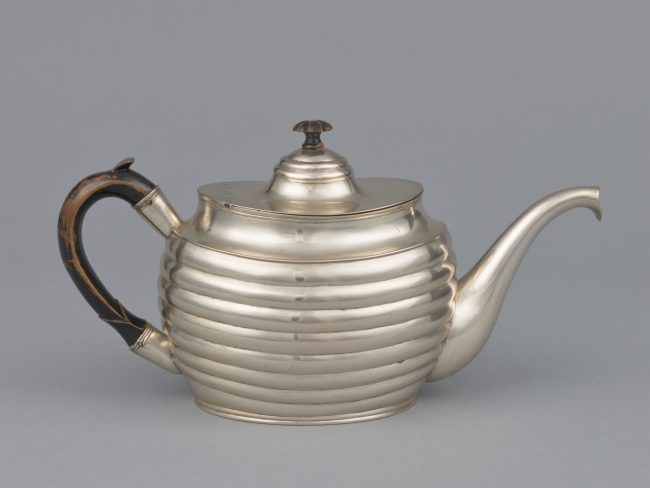
Silver teapot
Manufactured more than two hundred years ago at the workshop of Jan Maciej Schwartz (1772–1828) in Warsaw, the teapot pleases the eye with its lucid form and unconventional decoration consisting of transverse coils. Its meticulously crafted simplicity and impeccable finishing bear testimony to the class of the workshop. It is an interesting example of the classicistic aesthetic tendency in the Warsaw silver-smithing of the early 19th century.
During that period, workshops in Warsaw manufactured items characterised by simple harmonious forms. Such style resulted not only from the current fashion, but it was also motivated by economic conditions. After the collapse of the Polish-Lithuanian Commonwealth (divided between three partitioning states: Austria, Prussia and Russia between 1772 and 1795) and the turmoil of war, silversmiths adapted their offer to the financial potential of less affluent clients. Jan Maciej Schwartz, similarly to other outstanding Warsaw silversmiths of the era, was able to harness the purist aesthetics in the
production of refined items of silverware of noble proportions.
The teapot originally formed part of a tea set. Apart from the teapot , such sets also comprised a sugar bowl, a cream jug and a tray. Occasional additional elements included a bowl for washing teacups, a heater, a samovar for boiling liquid, another kettle and a coffee pot. The stormy history of Warsaw, particularly the period of World War II, led to the dispersal of the majority of sets. A complete set of silver tableware from a Warsaw workshop is a true rarity.
The teapot produced by Schwartz is larger than its 18th-century predecessors. Its size results from the decreasing price of tea. It boasts a bulging body, a lid, a low and archshaped ascending spout as well as a handle on the axis of the spout. This kind of structure is characteristic of such vessels.
The custom of drinking tea was introduced to the royal court by King Stanislaus Augustus Poniatowski (1732–1798, King of Poland 1764–1795), from where it was adopted by the Warsaw salons. It began to spread at the turn of the 19th century and gained popularity in the 1820s and 1830s. Tea was considered a sophisticated beverage, and therefore attention was paid to serving it in proper crockery. Its appearance, quality and refinement as well as the material used bore testimony to the wealth and taste of the owner. Tea sets were often made of silver, which lent them a refined shine, but unfortunately it was also a good heat conductor. Teapots were therefore equipped with wooden or bone handles and knobs, which significantly enhanced the comfort of use.
Well profiled handle with a base for the thumb as well as a properly curved spout ensured unproblematic outpouring of the beverage.
Silver teapot
JAN MACIEJ SCHWARTZ WORKSHOP
WARSAW; EARLY 19TH CENTURY
GILDED, CHASED SILVER, BLACKENED WOOD
MHW 17695
15,9 × 30 × 13,6 CM
Image: ![]()
